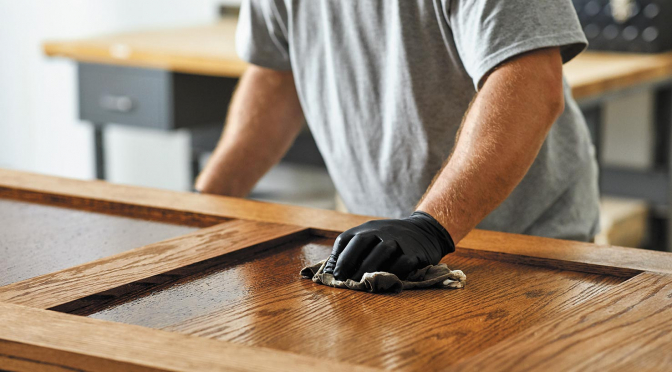Advances in wood finish technology offer endless color possibilities. In the article, we’ll talk about choosing the right stain color, how to get dark, rich color, and more stain color tips.
The beauty of wood
While wood in its natural state can provide breathtaking beauty, it doesn’t always match the other colors or wood tones in your customers’ homes and commercial properties. Adding stain to bare or stripped wood can both change the color and highlight the grain pattern of any interior wood.
Exclusively available at Sherwin-Williams, Minwax® is America’s No. 1 selling brand of interior stains and clear finishes. One reason: the Minwax Water-Based Wood Finish line offers more color choices than any other product on the market.
These top-selling finishes come in two opacities. Traditional semi-transparent stains showcase the wood grain and can be tinted to 240 colors. Solid stains show less wood grain but offer more color choices. Solid stains can be tinted to match almost anything.
How to get the right stain color
Since wood is a product of nature, it can vary from tree to tree, even in the same wood species.
Testing your stain is very important because the color of a stain, unlike a paint, is influenced by the wood it is applied to. You need to see the stain color on your particular wood before you can be sure of exactly what color you will end up with.
Before you apply stain to your piece, try it out either on an inconspicuous area of the piece or else on some sample wood that you used when you built the piece. Stain it in the same way you plan to stain your piece, following all the same steps. In this way, you can adjust the color and get it right before you tackle the real thing.
Getting dark, rich color with stain
Often, the first coat of stain gives you exactly the color you are looking for. However, there are times when you want a darker, richer color of stain.
To achieve a darker stain color, use coarser grit of sandpaper (150 to 180) on the last sanding you do prior to staining. This will help the wood absorb more color.
You can also leave the wet stain on the wood for longer before you wipe away the excess – sometimes as long as 15 minutes. This may help you achieve a deeper color.
In addition, you can try a second coat of stain to see if it deepens the color.
PRO TIP: Check the label directions for the particular stain you’re using to see the maximum time you can wait before wiping off the excess stain. Do NOT let the stain dry for longer than the label recommends.
More stain color tips
Sometimes, the wet stain is exactly the color that you’re looking for, but when the stain dries, it goes dull. Often, applying the clear protective finish will make the stain’s color rich again.
Try staining a sample (same material as the surface to be coated) and after it dries, apply the clear finish you plan on using. This will usually give the stain the depth, richness and warmth that you are after.
Oil-based topcoats, such as Minwax Fast-Drying Polyurethane, will impart some additional warmth and depth, while the water-based topcoats, such as Polycrylic Protective Finish, usually dry crystal clear. Test both and see which look you prefer.
Learn more
For more information and expert advice on wood stains and finishes, stop by your Sherwin-Williams paint store. Minwax products are available in-store, at sherwin-williams.com and the Sherwin-Williams PRO+ App.
This article was originally published in the Spring 2022 issue of PPC magazine. Visit the Sherwin-Williams contractor website for a full list of wood stains, sealers and clear topcoats.

